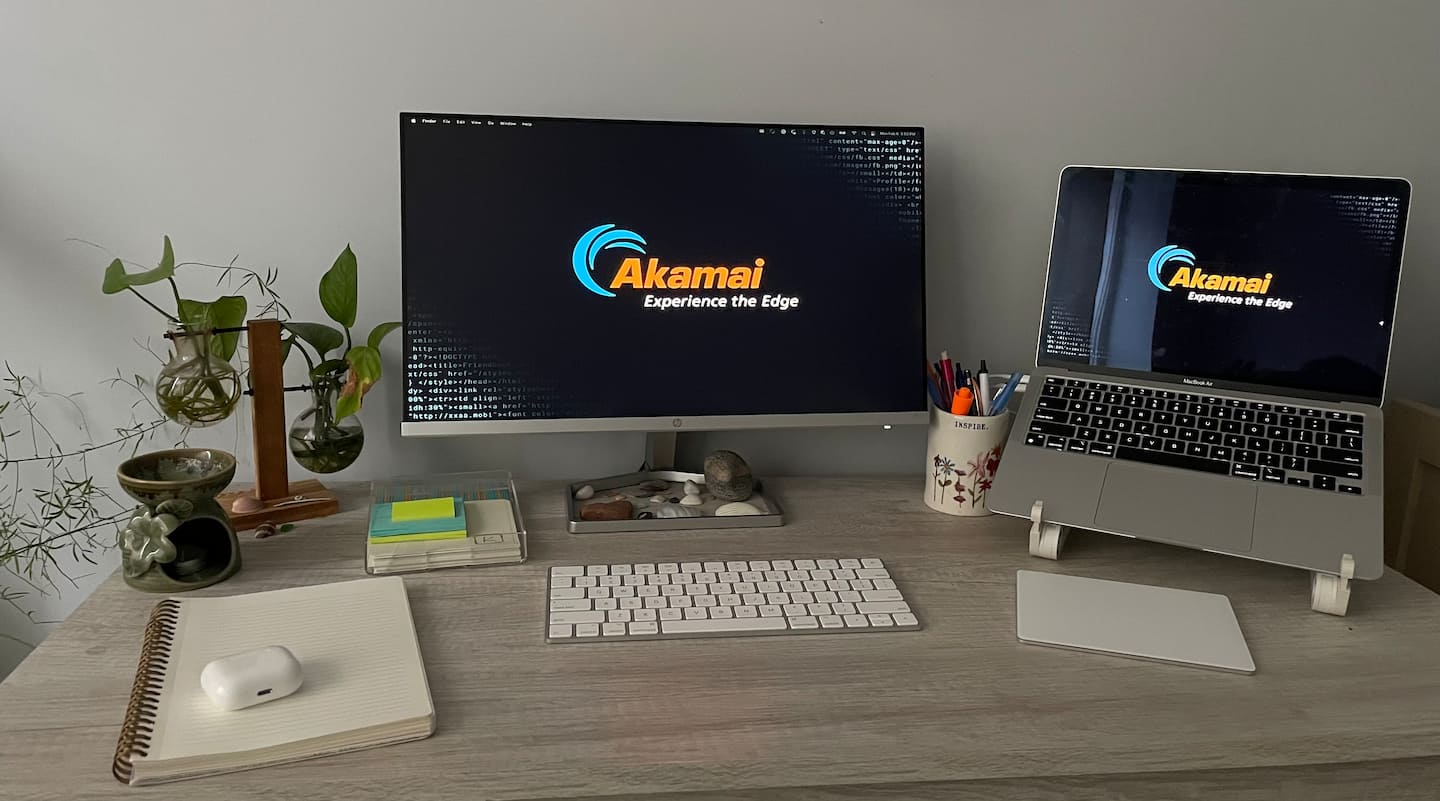Our Journey with FlexBase Emissions

I was pretty excited when I got my monitor, laptop stand, trackpad, and keyboard with Akamai’s FlexBase allowance to create my close-to-perfect work-from-home setup (see image below). A perfect setup for me would include a standing desk, but I still need to go to the office for that luxury.
For those of you who are unfamiliar with FlexBase, it is Akamai’s global flexible working program. FlexBase empowers employees by giving them workplace flexibility while still allowing each employee to designate a primary, or base, office location. Speaking about what makes the program so relevant, our Executive Vice President and Chief Human Resources Officer, Anthony Williams, commented, 'We believe in giving our employees the power of choice, so they can decide to work where they perform at their best.'
 An efficient work-from-home setup includes a monitor, laptop stand, trackpad, and keyboard.
An efficient work-from-home setup includes a monitor, laptop stand, trackpad, and keyboard.
With Akamai’s FlexBase program, employees have the power to choose where they decide to spend their workdays. Ninety-five percent of my Akamai colleagues have embraced the program, just like I have – working from our homes, offices, or both, and feeling empowered to decide where we will be most productive each day. As you can imagine, FlexBase at Akamai has created a whole new working world.
Sounds great, right? The power to choose, the work-life flexibility, the home-office allowance: There are a lot of benefits to the FlexBase program. But this new environment made our Sustainability team wonder: What is the emissions impact of this shift?
Understanding emissions across our value chain
It’s important for companies to have a full understanding of their impact and emissions, including the indirect emissions that typically fall into various categories within Scope 3 emissions. Understanding the total impact of our business is something that has long been a priority at Akamai. You can read more about our program in the Akamai 2022 ESG Impact Report.
We have built our Sustainability program to granularly track our emissions impact across Scopes 1, 2, and 3, and look for areas where we can delve deeper into understanding our impact and affect improvement. As they say, you can’t manage what you don’t measure. Our new FlexBase work environment has changed how we view and account for our emissions as a company.
Measurement changed when the world shut down
Work environments changed drastically when the world shut down for the COVID-19 pandemic, as we set up our laptops wherever we could find a private workspace in our homes. Prior to 2020, Akamai calculated and reported on employee commuting as one of our Scope 3 indirect emissions aspects. The pandemic drove commuting to a standstill, but that didn’t mean employees' emissions impact was forgotten.
We know that residential buildings account for approximately 20% of energy consumption. With our workload happening almost entirely in our homes, we transitioned to reporting employee work-from-home emissions instead of employee commuting emissions. We have established a very robust approach to calculate the power demand from a multi-monitor home office setup, and even included other work accessories and home HVAC and lighting. This approach has helped us gain much visibility into our globally dispersed workforce.
Measurement changed again when the world opened back up
Fast forward to today. The world has opened back up, and Akamai employees are choosing whether to commute to their local office or work from home … or both. With this new factor of employee choice, the accuracy of our employee emissions accounting again needed to be evaluated and adapted.
If you’re like me, you were eager to be back in the office with colleagues, and optimistic that you’d be in the office at least two days a week. But with your home office steps away, the reality may be one day a week in the local office, if that. In many cases, our estimate of how many days we’ll spend in the office becomes inaccurate.
With a little help from our friends
It was no surprise that Akamai’s Global Real Estate and Workplace Productivity (GREWP) team had already begun to track and analyze these employee commuting patterns and behaviors – we are a data-driven company, after all. GREWP has been collecting data from employees' badge swipes at our office locations around the globe.
Our FlexBase emissions model was the product of having a detailed view of employee activity and office use. With a little help from our friends on the GREWP team, the data came together without a hitch.
Improved accuracy
FlexBase has not only changed the way we view and account for our impact, but has also ushered in accuracy improvements by leveraging the datasets we already had internally. We have created a model that follows the employee decision to commute in or work from home and calculates the associated emissions impact based on the employees location.
When I took the lead on developing the model, it reminded me that our employees are spread all over the world. With this more granular approach of looking beyond where we have offices, we now have the opportunity to be more precise with the emissions factors we use to measure this impact.
Example: calculating emissions
Calculating the emissions associated with each employee is now done via a few questions in the model, such as:
Did this employee swipe into an Akamai office?
How often?
Where is the employee located?
Is this a local office or could this be a business travel activity?
How far are they from the office?
In a standard combustion car, what is the emissions impact of their commute?
What emissions factor applies to the employees’ location?
For the remaining days working from home, what is the estimated total power consumption of the employee’s home office?
Based on geographic location, what is the emissions impact of their usage?
We account for emissions based on the World Resources Institute Greenhouse Gas Protocol standards and use a combination of more than 500 greenhouse gas emission factors across our value chain.
Lessons learned
It was interesting to develop a decision-based approach to understand the employee commute. Even though business travel is not back to prepandemic levels, we do have employees who are traveling and visiting offices around the globe. Since we account for corporate travel as an indirect emissions source as part of our Scope 3 reporting, we needed to be sure that the model would be able to determine whether a badge swipe is coming from a local or visiting employee.
Collaboration is crucial
Cross-organization collaboration was essential as we built the model. As more data sources were revealed at the company, we were able to apply proper logic to the model to improve accuracy. When I was deep into the intricacies of the model, testing to ensure all was working properly, I relied on colleagues — on and beyond my team — for their help and historical knowledge.
I’m excited to see this approach continue to evolve to better understand employee behavior and inform our decision-making. We will continue to uncover areas for improvement in our measurement, especially as we work toward our net-zero emissions goal. In the future, we will leverage our employee commuting and work-from-home insights as opportunity areas to “green-up” our home offices or incentivize low-carbon commuting options, as Akamai continues to value employees’ choice of their work location.
On our way to net-zero
Having had the opportunity to build an emissions model for the first time, I will leave you with this final thought: It is rare that you will have perfect data. But this should not hold you back from calculating your environmental impact across your value chain.
Scope 3 emissions are often hard to calculate, and sometimes you may need to estimate. Embrace this ambiguity. Within this new world of workplace choice, we encourage you to join us in understanding your organization’s Scope 3 impact wherever your employees are located. Having a clear view across your value chain emissions is critical for all of us to achieve true net-zero.


